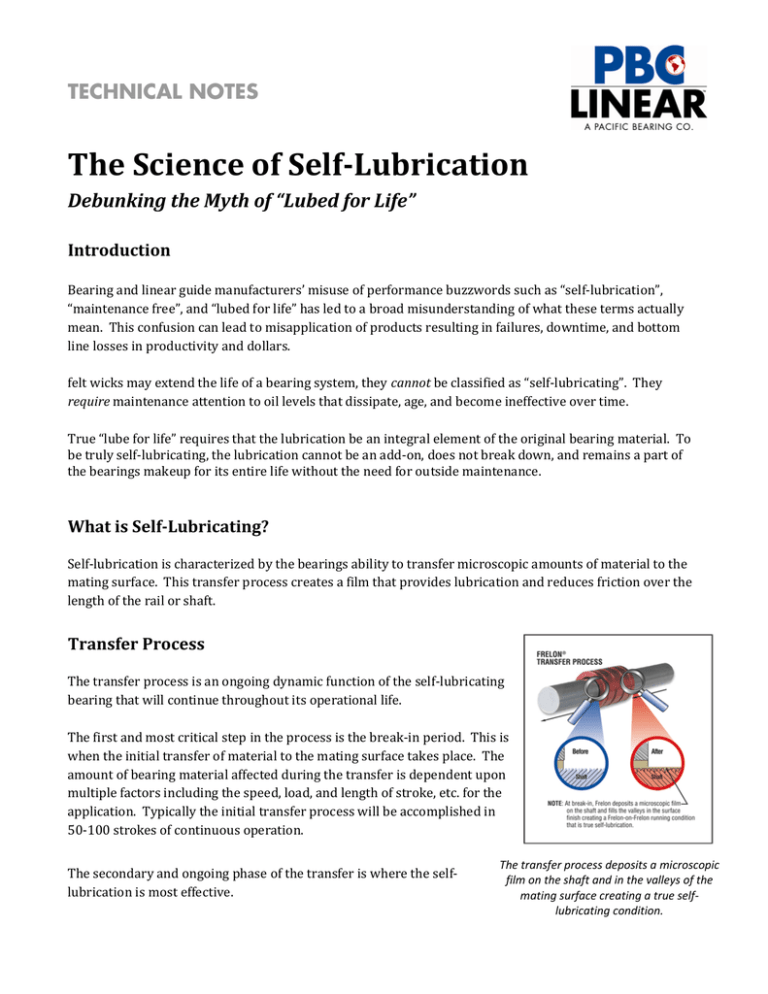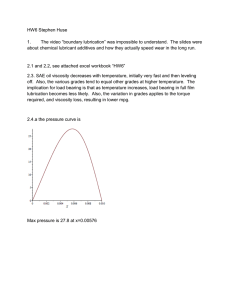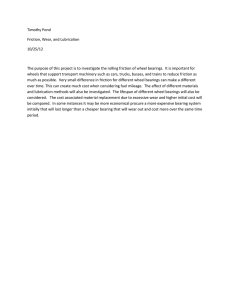The Science of Self-Lubrication
advertisement

TECHNICAL NOTES The Science of Self­Lubrication Debunking the Myth of “Lubed for Life” Introduction Bearing and linear guide manufacturers’ misuse of performance buzzwords such as “self‐lubrication”, “maintenance free”, and “lubed for life” has led to a broad misunderstanding of what these terms actually mean. This confusion can lead to misapplication of products resulting in failures, downtime, and bottom line losses in productivity and dollars. felt wicks may extend the life of a bearing system, they cannot be classified as “self‐lubricating”. They require maintenance attention to oil levels that dissipate, age, and become ineffective over time. True “lube for life” requires that the lubrication be an integral element of the original bearing material. To be truly self‐lubricating, the lubrication cannot be an add‐on, does not break down, and remains a part of the bearings makeup for its entire life without the need for outside maintenance. What is Self­Lubricating? Self‐lubrication is characterized by the bearings ability to transfer microscopic amounts of material to the mating surface. This transfer process creates a film that provides lubrication and reduces friction over the length of the rail or shaft. Transfer Process The transfer process is an ongoing dynamic function of the self‐lubricating bearing that will continue throughout its operational life. The first and most critical step in the process is the break‐in period. This is when the initial transfer of material to the mating surface takes place. The amount of bearing material affected during the transfer is dependent upon multiple factors including the speed, load, and length of stroke, etc. for the application. Typically the initial transfer process will be accomplished in 50‐100 strokes of continuous operation. The secondary and ongoing phase of the transfer is where the self‐ lubrication is most effective. The transfer process deposits a microscopic film on the shaft and in the valleys of the mating surface creating a true self‐ lubricating condition. Common Misconceptions Clever advertising gimmicks and inaccurate training materials are claiming “self‐lubricating” or “lubed for life” capabilities for systems or components that do not fit the definition of the lubrication being an integral element of the bearing material. Below is a description of some of these types of systems. Types of Non Self­Lubricating Systems Rolling Element Systems These include rotary (ball and roller) bearings, round‐way linear ball bearings, and rolling element profile type monorail designs. All of these systems require some kind of external lubrication to operate. The metal‐to‐metal contact of the rolling element against the raceway necessitates that there be grease or oil present at all times. If this external lubricant is not present, the ball or roller will begin to make direct contact with the shaft or rail material resulting in galling and brinelling damage. Many manufacturers attempt to overcome this weakness in the design by adding oil‐impregnated seals to the ends of the bearing or housing. This approach can result in some benefit to the life a rolling Oil impregnated bronze These bronze bearings are very porous and have lightweight oil soaked into the material. Under the optimum conditions, this oil is drawn to the bearing surface creating a lubricated layer between the bearing and the shaft. Graphite plugged bronze Graphite is a good solid lubricant that is normally added to a bronze type bearing. Solid plugs of graphite are usually inserted into holes in the base bronze. Teflon coated materials PTFE can be used to coat bearing surfaces in several ways. It can be applied as either a part of a powder simply dusting the bearing. It can be a sprayed mixture that adheres to the bearing surface. Or it can be part of a liquid or grease compound applied to the bearing. Any of these methods results in a very thin layer of actual lubricant that is quickly worn away and becomes ineffective. Oil impregnated plastic Here again, lightweight oil is added to the base material to aid in bearing lubrication. The result is decreased friction initially, but lubricant aging and dissipation quickly reduce its effectiveness. What makes a system self­lubricating? 1. The lubrication is an integral component of the bearing material. 2. The oil or grease is NOT added to the original bearing design. 3. The oil or grease will NOT breakdown and be ineffective over time (lubricant ageing or aging). 4. The oil or grease is consistently applied to the shaft surface. 5. Additional components do not add cost to the overall system. shaft or bearing damage and reduce system life. (Double edge sword of rolling element bearings) To truly be self­lubricating, a bearing system must do exactly what the name implies. It must provide its own lubrication throughout the life of the system and not have some external source facilitating lubrication for a period of time. It must be designed and manufactured into the bearing material from the beginning. One example of this is PBC Linear’s Simplicity® self‐ lubricating liner. The Advantages of Simplicity Frelon® Liner • No metal‐to‐metal contact • No galling or brinelling • No added lubricants to attract additional contaminants • Dampens vibration for smooth and quiet operation • Actual “maintenance free” operation Proven Success in PBC Linear™ Products • Simplicity Linear Plane Bearings • Uni‐Guide™ Modular Guides & System • Mini‐Rail® Miniature Linear guide Summary The term “self‐lubricating” should not evoke a generalized meaning that passively represents a broad range of different technologies striving for the same outcome. Self‐lubricating refers to a specific linear motion performance advantage made possible by a unique product design that satisfies all aforementioned criteria: internal lubrication system, no added grease or oils, no lubrication breakdown and no added cost. In other words, “self‐lubricating” must ensure the clean and maintenance‐free operation in the most challenging environments. Designers need to learn to recognize the difference between the various types of lubrication options. Failure to do so will result in costly misapplications and re‐designs. © Copyright 2010 PBC Linear™


